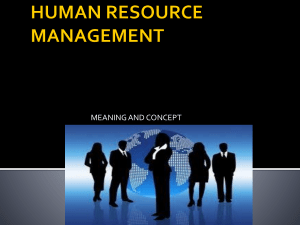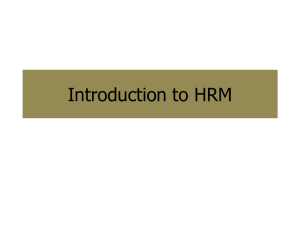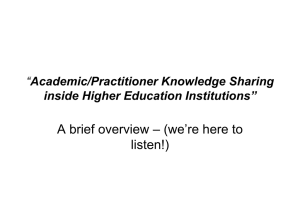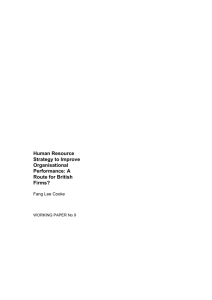The increasingly important role of Human Resource Management is
advertisement
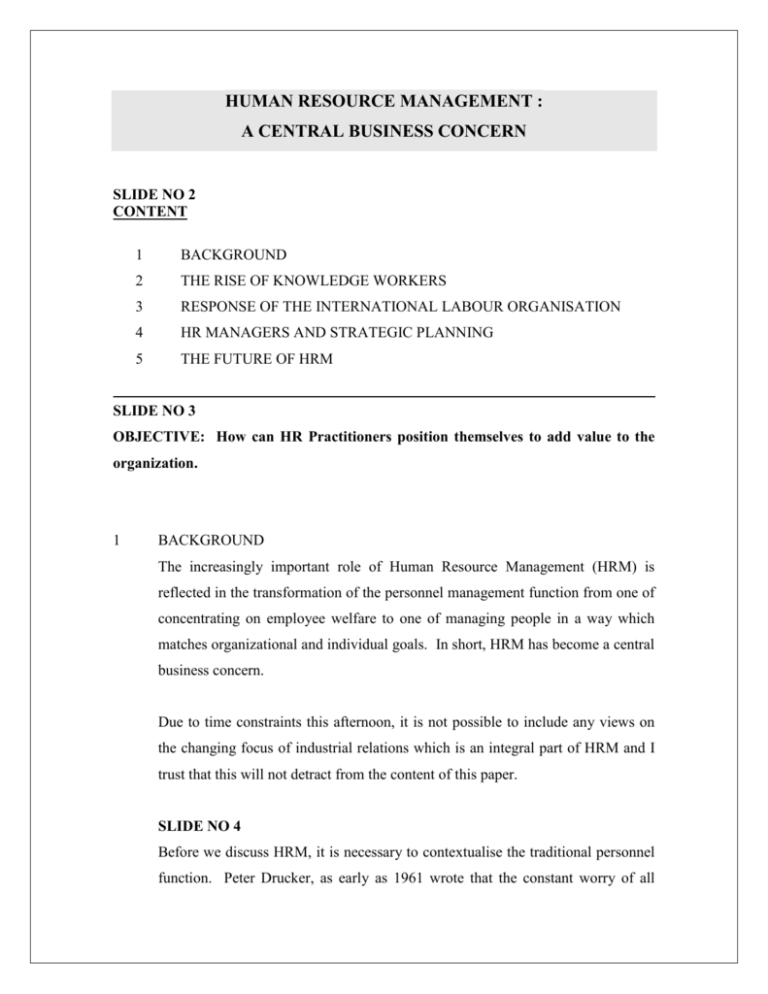
HUMAN RESOURCE MANAGEMENT : A CENTRAL BUSINESS CONCERN SLIDE NO 2 CONTENT 1 BACKGROUND 2 THE RISE OF KNOWLEDGE WORKERS 3 RESPONSE OF THE INTERNATIONAL LABOUR ORGANISATION 4 HR MANAGERS AND STRATEGIC PLANNING 5 THE FUTURE OF HRM SLIDE NO 3 OBJECTIVE: How can HR Practitioners position themselves to add value to the organization. 1 BACKGROUND The increasingly important role of Human Resource Management (HRM) is reflected in the transformation of the personnel management function from one of concentrating on employee welfare to one of managing people in a way which matches organizational and individual goals. In short, HRM has become a central business concern. Due to time constraints this afternoon, it is not possible to include any views on the changing focus of industrial relations which is an integral part of HRM and I trust that this will not detract from the content of this paper. SLIDE NO 4 Before we discuss HRM, it is necessary to contextualise the traditional personnel function. Peter Drucker, as early as 1961 wrote that the constant worry of all 2 personnel administrators is their inability to prove that they are making a contribution to the enterprise. They are also, he said, preoccupied with the search for a 'gimmick' that will impress their management associates. And he argued, they have a persistent complaint – “we lack status”. Some wit once said that 'personnel management' is all those things that do not deal with the work of people and that are not management." So what has changed? 2 SLIDE NO 5 THE RISE OF KNOWLEDGE WORKERS The rise of knowledge workers! The blue collar worker which had previously dominated the middle of the century has not disappeared into oblivion because workers have merely evolved into another class – that of being knowledge workers. The term knowledge worker was coined by Peter Drucker in his book “Landmarks of Tomorrow” way back in 1959. He stressed back then that the knowledge worker will require qualifications and the ability to acquire and apply theoretical and analytical knowledge. Above all, he noted, will be the requirement that a habit of continuous learning is acquired. Education is fundamental to labour productivity and to the wage that workers can command. The knowledge worker shift has taken place in most parts of the world. The rise of knowledge workers means that developing countries can no longer expect to base their competitiveness on the comparative basis of cheap industrial labour. Countries will have to excel at basing their competitive advantage on how knowledge is applied. For example, in Japan, the total quality management system, the lean manufacturing process and Just-in-Time (JIT) delivery created a competitive edge. In Switzerland, customer service is promoted. SLIDE NO 6 3 RESPONSIVE OF THE INTERNATIONAL LABOUR ORGANISATION 3 In line with the knowledge worker revolution, the June 2003 International Labour Conference of the International Labour Organisation (ILO) considered the revision of the ILO’s Human Resources Development Recommendation of 1975 and some of the proposed amendments are listed below. This recommendation will be finalised at the 2004 International Labour Conference. The Objective of the review is that member countries (South Africa is a member) should formulate, apply and review national human resources development and education and training policies, which are consistent with other economic and social policies, based on the social dialogue of government and the social partners. The review recommends that member countries should recognize that the realization of lifelong learning is based on the explicit commitment by: governments - to invest in enhancing education and training at all levels; the private sector - to train employees; and individuals – to develop their own abilities and careers. South Africa has indirectly confirmed its support of this principle which is evidenced by the Skills Development legislation. In addition, the review should recognise that the term “lifelong learning” encompasses all learning activities undertaken throughout life for the development of competencies and qualifications. SLIDE NO 7 Very briefly, it is recommended that members will be encouraged to identify human resources training and development policies which: 4 (a) facilitate lifelong learning and employability; (b) give equal consideration to economic and social objectives, and emphasize sustainable economic development in the context of the globalizing economy; (c) stress the importance of innovation, competitiveness, productivity and growth of the economy, SLIDE NO 8 (d) address the challenge of transforming activities in the informal economy into decent work fully integrated into mainstream economic life. (e) promote and sustain public and private investment in the infrastructure needed for the use of information and communication technology in education and training; and (f) address and reduce inequalities in the participation of adults in education and training. Clearly then, the role of personnel management has broadened. The competition generated by globalisation and the rapid technological changes that have accompanied globalisation has created a class of worker to whom knowledge and skills have become the most important determinants of investment opportunities, productivity and quality and flexibility. Now since productivity and quality have become major considerations in competitiveness, the quality of the workforce and training have become critical factors. 4 HUMAN RESOURCE MANAGERS AND STRATEGIC PLANNING But how can HR Managers ensure that the knowledge economy, the global marketplace and the complexity of South Africa’s labour legislation do not forever dilute the role of the HR practitioner? 5 If one takes into account global comparisons of how specific practices of human resources impact on economies, then the following is consistently evident: the major trading blocks like Europe, North America and the Asian Pacific countries attach emphasis on specific practices such as deriving value from human capital, implementing well-designed practices and comprise a highly efficient HR function closely aligned with business needs. In contrast, developing countries such as China, India and Malaysia have as their prime focus to get the basics right ensuring that payroll and effective recruitment and performance management practices are in place. It is an imperative that HR Managers must understand the nature of the business in which they are operating and be allowed to contribute to the formulation of the organisation’s strategic plan. The trick is to determine how HR can contribute to ensuring that the strategic plan is implemented. SLIDE NO 9 There are 6 key steps that every HR practitioner should ensure are included in the strategic planning process: Hiring and selection Include tactics for recruiting, hiring and promotion. The skills knowledge and abilities critical to the success of each position should be included. Training and Development The strategic plan should cover technical, management and leadership skills plans for all managers and employees. Productivity Develop a performance management system that identifies the essential functions of each job, evaluate and provide feedback on performance and REWARD good 6 performance. Focus on key performance areas that will achieve the organization’s strategic plan. Organisational Planning and Development The culture of an organization, usually developed over time, is the underlying principles and values of an organization that drive the behaviour of individuals and groups. Changes in culture may need to be considered in strategic planning especially in the South African context in terms of transformation. HR can help to focus on how the organization is structured to get the work done, how communication occurs and how organizational values drive behaviours and decisions. Key function organization charts should be reviewed and strengths, weaknesses and concerns identified. In addition to these concerns, consolidate and list the principle manpower concerns that require addressing. Reward and Recognition Systems HR can take an active role in the planning process by including the design of monetary reward systems and incentive programmes. Non-monetary reward systems usually focus on specific organizational objectives. The plan should periodically assess the behaviours being rewarded through these systems. The right mix of pay and benefits is crucial. In North America, a key item of a reward package is that pay is linked to performance. In Asia, where packages are lower, a competitive yet guaranteed reward package appears to be more important. The global benchmark is to build the right reward framework linked with the refusal to accept substandard performance. 7 HR Administration Administration matters are an important consideration in strategic planning. This includes payroll, maintaining employee information systems, and administering the compensation and employee benefit plans for the organization. It should be noted that the above HR functions are all inter-connected and interdependent; when changes are made in one function, other functions can be effected. To implement the strategic plan it is important that all functions should interact and move in the same direction. SLIDE NO 10 Much controversy often exists between the line management responsibility of the HR practitioner, and the functional responsibility. In an ideal world, line managers and HR managers should work together to promote the strategic aims of the business. However, politicing often takes place and friction develops when HR practitioners report to line management as well as a functional supervisor. It has been suggested that to resolve any possible conflict, HR practitioners should offer their services as consultants to line managers. I’m sure you will agree this is a thought provoking suggestion! And thirdly, it is necessary for HR practitioners to continuously improve themselves, their skills and their knowledge in line with the requirements of the knowledge economy. The main focus of the HR practitioner’s role is still to ensure that employees are developed and are able to grow to their optimum level. Personal development will not happen effectively without regular careful assessment and career planning. Feedback is important to identify weaknesses and ensure that development takes place. The indirect result of this is that the workplace will become a rewarding place in which to work. 8 SLIDE 11 5 THE FUTURE OF HRM In conclusion then, it is necessary to ensure that HRM theory is integrated into the organization and the following conditions need to be satisfied: HRM should form an essential part of management education and training. This will result in HRM being integrated into corporate strategies and line manager’s functions and decisions which will result in business strategies being built around competitive advantages such as flexibility, quality and customer service. A substantial investment in people and the willingness of employers to view the benefit of a long-term perspective. This is in contrast to the current system where short-term investor pressure is the driving force. Bear in mind that HRM’s greatest weakness is that it does not recognize that the choices available to management are governed by internal but also by external considerations. HRM must not be seen to be the preserve of the individual firm acting in isolation but rather be seen to be a part of a wider economy. I THANK YOU. Prepared by : © SACOB 3 November 2003 Carol O’Brien Policy Executive: Labour and Social Policy SOUTH AFRICAN CHAMBER OF BUSINESS



